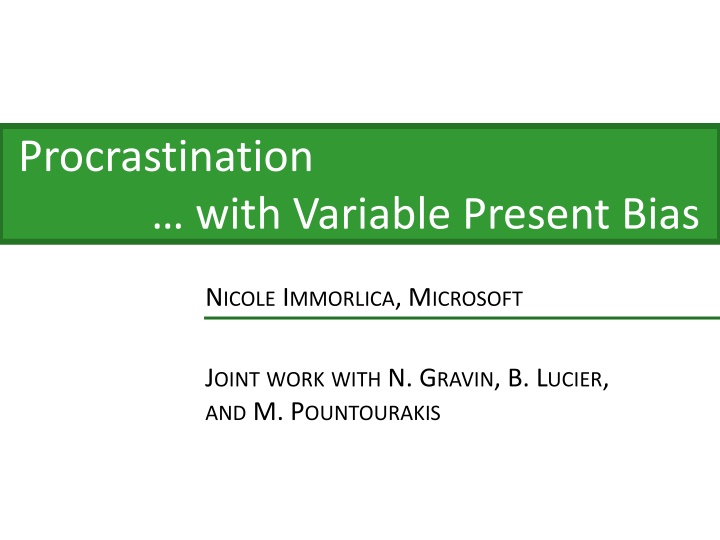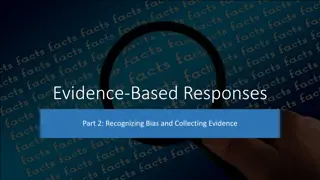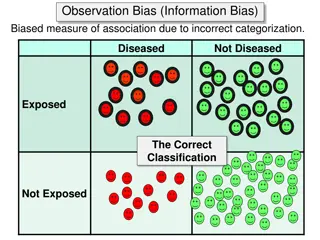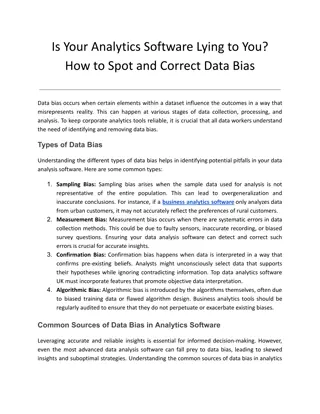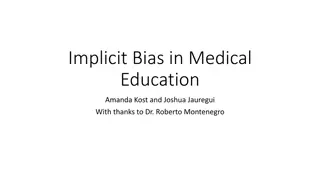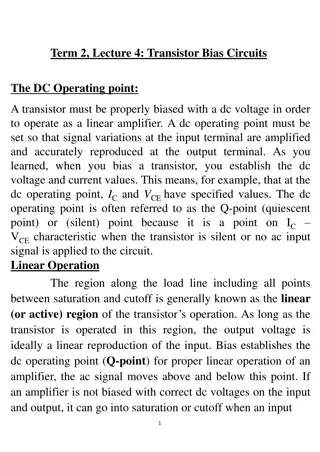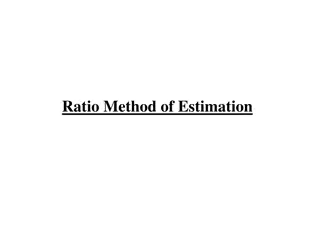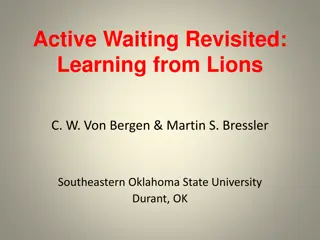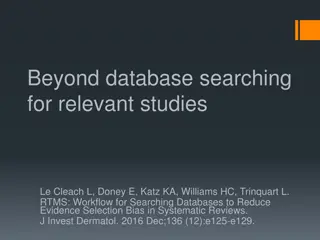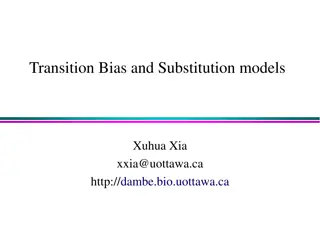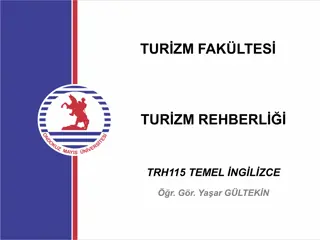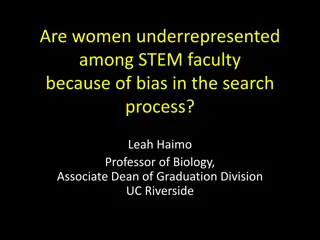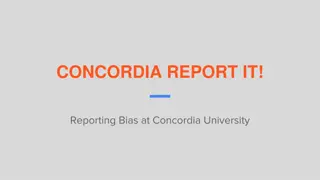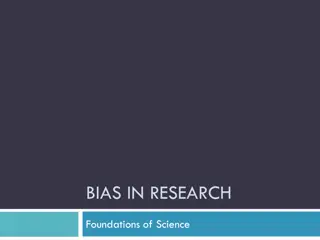Procrastination with Variable Present Bias
This study delves into the concept of procrastination intertwined with variable present bias, exploring intertemporal tradeoffs and the impact of present-bias discounting on decision-making processes.
Download Presentation

Please find below an Image/Link to download the presentation.
The content on the website is provided AS IS for your information and personal use only. It may not be sold, licensed, or shared on other websites without obtaining consent from the author.If you encounter any issues during the download, it is possible that the publisher has removed the file from their server.
You are allowed to download the files provided on this website for personal or commercial use, subject to the condition that they are used lawfully. All files are the property of their respective owners.
The content on the website is provided AS IS for your information and personal use only. It may not be sold, licensed, or shared on other websites without obtaining consent from the author.
E N D
Presentation Transcript
Procrastination with Variable Present Bias NICOLE IMMORLICA, MICROSOFT JOINT WORK WITH N. GRAVIN, B. LUCIER, AND M. POUNTOURAKIS
intertemporal tradeoffs. Incur short-term costs for long-term payoff. Examples. Speaker: prep talk or go to the movies? Student: study or party? Marathoner: training run or sleep? Skier: buy skies or rent? In general. An agent makes a sequence of costly decisions, where costs and options depend on previous choices.
talk prep example. Task graph. progress 0 0 done 2 2 2 1 1 undone days Day 1: abstract submitted Day ? + 1: day of talk
talk prep example. Minimum cost path. progress 0 0 done 2 2 2 1 1 undone days Day 1: abstract submitted Day ? + 1: day of talk
talk prep example. Anecdotal path. progress 0 0 done 2 2 2 1 1 undone days Day 1: abstract submitted Day ? + 1: day of talk
talk prep example. Actual path. progress 0 done 2 2 2 1 1 undone days Day 1: abstract submitted Day ? + 1: day of talk
present bias. Definition [Akerlof 91]. Present-bias discounting is a form of hyperbolic discounting in which, at each point in time, individuals inflate present costs by a model parameter ? > 1. cost of plan =? (today s costs) + future costs
talk prep example. Plan of action for present-bias ? > 2. progress 0 0 0 done 2 2 2 2 1 1 1 undone days
talk prep example. Plan of action for present-bias ? > 2. progress 0 0 0 done 2 2 2 2 1 1 1 undone days
talk prep example. Plan of action for present-bias ? > 2. progress 0 0 0 done 2 2 2 2 1 1 1 undone days Linearly-higher cost than optimal plan!
talk prep example. Plan of action for present-bias ? < 2. progress 0 0 0 done 2 2 2 2 1 1 1 undone days Model only makes extreme predictions.
variable present-bias. Definition [this paper]. In variable present-bias, the present-bias factor ? is drawn IID from a distribution ? at each point in time. 1 e.g., ? = 1 w/prob. 3 w/prob. (no procrastination) 3 2 3 Allows for intermediate behaviors in example.
question. What is impact of variable present-bias and task graph structure on cost of procrastination? Definition [Kleinberg-Oren 14]. Procrastination ratio is the ratio between the expected weight of the traversed path and the weight of the initial shortest path.
results (informal). Main lemma. For any distribution, worst task graph has just two progress levels, with cost to move up. What bounds procrastination ratio? 1. If task graph has [some property], then the procrastination ratio is at most linear. 2. If task graph has [a more stringent property], and the agent has a low tendency to procrastinate, then the procrastination ratio is at most constant.
related work. Quasi-hyperbolic discounting. [Akerlof 91], [Laibson 97], [Frederick et al. 02] Structural conditions on task graph. (excluded minor) that imply bounded procrastination ratio, for fixed ?. [Kleinberg and Oren 14], [Teng et al. 15] Potential interventions. Improved performance through choice reduction, delaying information, sophistication. [O Donoghueand Rabin 99], [Ely 15], [Kleinberg et al. 16]
outline. Model and statement of results. Main lemma and connection to optimal pricing.
model. Task graph. graph with ? + 1 layers, designated start node ?, end node ?, and edge weights between layers. ? progress ??? ? ? ? days 1 2 3 ? ? + 1
model. Task graph. graph with ? + 1 layers, designated start node ?, end node ?, and edge weights between layers. Agent behavior. Each day ? = 1 ?, agent at node ? draws bias ? ? and selects edge ?,? minimizing: ? ? ?,? + ????(?,?). Definition. Procrastination ratio is the ratio between the expected weight of the traversed path and the weight of the initial shortest path.
extremal task graphs. Main lemma. For any distribution, worst task graph is progress 0 0 done ?? 1 ? 0 0 undone days where ? 1 depends on the distribution ?.
student example. Exponential ratio even with constant prob. of rationality. progress 0 0 0 done 32 33 3 13 23 3? ? = 1 w/prob. 3 w/prob. 0 0 0 undone days ? 1 2 3 1 3 3?= 2? 1, ? Expected cost = ?=1 whereas optimal cost is only = 3.
bounded distance. Definition. A task graph satisfies bounded distances if ???? ?,? ????(?,?) for all ?. Non-example: ???? ?,? = 33> ???? ?,? = 3 0 0 0 32 33 3 3? 0 0 0 ?
bounded distance. Definition. A task graph satisfies bounded distances if ???? ?,? ????(?,?) for all ?. Theorem. If the task graph satisfies bounded distances, the procrastination ratio is at most linear. Proof. Each day, present-day cost ??? of planned path is at most total cost of shortest path ????(?,?).
training for a marathon. 0 0 Level ? ?-1 1 1 Level 2 0 0 ? 1 1 1 Level 1 ? ? days Minimum cost training plan = ?.
training for a marathon. Perceived cost of options. + ? ? + 1 1 13 23 ? = 1 w/prob. 3 w/prob. Level ? + ? ? 1 0 a biased random walk with downward drift. ? Claim. If ? log n, procrastination ratio This can be improved to ?, giving a tight bound. log ?.
monotone distance. Definition. A task graph satisfies monotone distances if ???? ?,? ????(?,?) for every edge (?,?). Non-example. ???? ?,? = ? > ???? ?,? = ? 1 1 Level 2 ? 1 1 Level 1 ?
monotone distance. Definition. A task graph satisfies monotone distances if ???? ?,? ????(?,?) for every edge (?,?). Main theorem. If task graph has monotone distances, and [distribution ? places sufficient mass near 1], then the procrastination ratio is constant. Sufficient condition: distribution has point mass at 1.
renting skies. Minimum cost plan of action = 1. 0 0 0 own 1 1 1 1 2 3 2 3 2 3 rent days Plan of action for present bias ? = 3.
renting skies. Minimum cost plan of action = 1. 0 0 0 own 13 23 1 1 1 ? = 1 w/prob. 3 w/prob. 1 2 3 2 3 2 3 rent days ? 1 2 3 1 3 2 3+ 1 = constant. ? E[cost] = ?=1 ? 1
outline. Model and statement of results. Main lemma and connection to optimal pricing.
extremal task graphs. Main lemma. For any distribution, worst task graph is progress 0 0 done ?? 1 ? 0 0 undone days where ? 1 depends on the distribution ?.
extremal task graphs. Proof. WLOG, set ???? ?,? = 1. In ? th step, construct: progress states of layer ? + 1, weights of edges from layer ? to ? + 1, and shortest continuation path weights from layer ? + 1 to end state ?, to maximize ratio subject to constraints on shortest continuation path weights from layer ? to end state ?. Idea: draw analogy to single-agent pricing problem.
extremal task graphs. Procrastinating agent, bias parameter ? ?: Planning Pricing Procrastinating agent Single buyer for a single item Present bias parameter ?~? Value ?~? Menu: ???? ?1,? ?1 Choose parameters to max incurred cost, i.e., linear function of weight and distance. ?1,?1 (?2,?2) (??,??) ???? ?2,? ? ?2 ?? ???? ??,? Agent objective: min j Buyer utility: max ? {? ?? ??} ? ??+ ???? ??,? ? 1 ???? ??,? ???? ??,? ???? ?,? max ???? ?,? ?
extremal task graphs. Theorem [Myerson 81]. For objectives linear in allocation and revenue, and any menu with individual rationality, there is an optimal IR menu with just two items: item price allocation 0 0 ?1 ? 1 ?2 where ? 1 if value is supported on [1, ).
extremal task graphs. Worst-case task graph, layer ? + 1: Menu item: ?2= ????(?,?) ?? ???? ?2,? = 0 ?2 (0,0) ? ?1= 0 ?1 ???? ?1,? = ? ????(?,?) (1,?) subject to constraint on ????(?,?). ?? ???? ??,? ???? ?,? (allocation, price)?= 1 , ???? ?,?
extremal task graphs. Main lemma. For any distribution, worst task graph is progress 0 0 done ?? 1 ? 0 0 undone days where ? 1 depends on the distribution ?.
summary. Defined a special case of hyperbolic discounting with variable present bias as a model of temporal myopia. Provided conditions on task graph and bias distribution that guarantee low procrastination ratio. bounded distance: never dig yourself into a hole monotone distance: always make progress towards climbing out of the hole low tendency to procrastinate: present-bias distribution places sufficient weight close to 1
